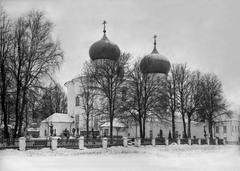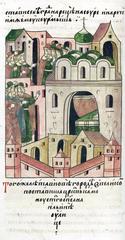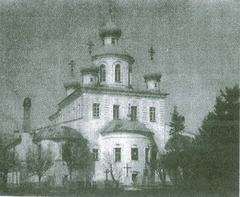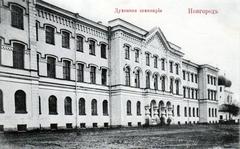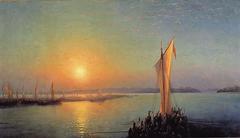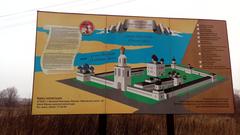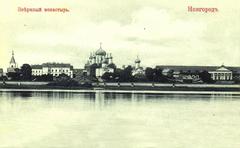
Dukhov Convent Visiting Hours, Tickets, and Travel Guide: Veliky Novgorod Historical Sites
Date: 04/07/2025
Introduction
Nestled in the heart of Veliky Novgorod, the Dukhov Convent (Convent of the Holy Spirit) is a living symbol of Russia’s medieval religious and cultural heritage. Founded in the late 14th or early 15th century, during the zenith of the Novgorod Republic, it remains a spiritual sanctuary for women and a hub for cultural and charitable activities. The convent’s thick walls, domed architecture, and precious medieval frescoes exemplify the Novgorod school, while its ongoing restoration reflects the city’s resilience and dedication to heritage. This guide provides comprehensive information on visiting hours, ticketing, accessibility, tours, and tips for exploring the Dukhov Convent and nearby UNESCO-listed sites.
For additional resources, refer to Travel All Russia, UNESCO, and Audiala.
Contents
- Introduction
- Historical Overview
- Architectural and Religious Significance
- Role in Novgorod’s Religious and Social Life
- Political Upheavals and Restoration
- Notable Features and Artistic Heritage
- Visiting the Dukhov Convent: Essential Information
- Visiting Hours
- Ticket Information
- Accessibility
- Guided Tours
- Getting There
- Nearby Attractions and Itineraries
- Photography and Events
- FAQ
- Plan Your Visit
Historical Overview
The Dukhov Convent reflects the layered legacy of Veliky Novgorod, one of Russia’s oldest cities, first chronicled in 859 CE (Wikipedia). Established in the late 14th or early 15th century, it arose during a period of Novgorod’s cultural and religious flourishing, when the city was governed by a veche (popular assembly) and renowned for its autonomy and vibrant civic life (World Heritage Site). The convent was founded as a female monastic community for women of noble and merchant backgrounds, offering sanctuary, education, and spiritual devotion.
Architectural and Religious Significance
The convent’s main church, dedicated to the Descent of the Holy Spirit, is an exemplar of Novgorodian ecclesiastical architecture: thick stone walls, harmonious proportions, and distinct domes (World Heritage Site). Over centuries, the ensemble evolved through cycles of fire, war, and restoration, blending brick and white stone with local craftsmanship. Frescoes and icons created by Novgorod’s esteemed painters adorn the church interiors, reflecting the city’s role as a cradle of Russian art (Wikipedia).
The convent’s spiritual life centers around Pentecost, with special liturgies and processions. The nuns—renowned for strict monastic discipline—engaged in prayer, charitable works, and the preservation of Orthodox traditions (RBTH). The convent also preserved icons and relics, some considered miraculous, which continue to attract pilgrims.
Role in Novgorod’s Religious and Social Life
Throughout its history, the Dukhov Convent was more than a religious institution. It contributed to manuscript copying, charitable care, and the education of women, supporting Novgorod’s intellectual and social fabric (Travel All Russia). Annual celebrations, especially Pentecost, were major city events, strengthening communal bonds and religious identity.
The convent’s choir and artisans contributed to the development of local liturgical music and arts, with embroidered vestments and banners produced for churches across the region.
Political Upheavals and Restoration
The annexation of Novgorod by the Grand Duchy of Moscow in the late 15th century brought changes in governance but the convent remained active (Wikipedia). The secularization reforms of the 18th–19th centuries, and later Soviet repression, led to the loss of lands, the closure of religious institutions, and the dispersal of art and relics (Travel All Russia). Since the 1990s, concerted restoration has stabilized the convent’s structures and revived its religious functions. It is now a key component of the UNESCO-listed Historic Monuments of Novgorod and Surroundings (UNESCO).
Notable Features and Artistic Heritage
The main church is noted for its simple beauty—thick walls, modest ornamentation, and enduring medieval frescoes (World Heritage Site). The convent’s icons, many attributed to Novgorod’s school of painting, are vibrant and spiritually expressive. The layout, with residential quarters, refectory, and gardens, reflects the monastic ideals of seclusion and self-sufficiency.
Visiting the Dukhov Convent: Essential Information
Visiting Hours
- General hours: 9:00 AM to 6:00 PM daily; last entry at 5:30 PM.
- Note: Hours may vary during religious holidays or special events. Always check the convent’s official website or the local tourist center (Audiala).
Ticket Information
- Admission: Free for worshippers attending services.
- Tourists: A small entrance fee (~200 RUB) may apply for museum areas or exhibitions.
- Tickets: Available on-site; group tours may require advance booking.
Accessibility
- General: Most of the grounds are level; however, historic buildings may have steps or uneven surfaces.
- Assistance: Ramps and support are available at main entrances; contact the convent ahead for specific needs.
Guided Tours
- Languages: Russian; English tours may be arranged via local agencies or the tourist center.
- Booking: Book on-site or in advance, especially for groups. Audio guides and printed materials are sometimes available.
Getting There
- Location: Central Veliky Novgorod, within walking distance of the Kremlin and city center.
- Transport: Reach by foot, taxi, or local bus from train and bus stations. Veliky Novgorod is accessible by train from St. Petersburg (3–4 hours) and Moscow (8–10 hours by overnight train).
Dress Code and Etiquette
- Women: Skirts/dresses covering the knees; tops covering shoulders; headscarf in churches.
- Men: No shorts or sleeveless shirts.
- General: Quiet, respectful behavior; silence phones; photography inside churches only with permission.
Nearby Attractions & Sample Itineraries
Key Attractions
- Novgorod Kremlin (Detinets): 11th-century fortress, home to Saint Sophia Cathedral, Millennium of Russia Monument, and museums (World Heritage Site).
- Saint Sophia Cathedral: Russia’s oldest stone church, famous for frescoes and icons (TravelSetu).
- Yaroslav’s Court and St. Nicholas Cathedral: Open-air museum, original medieval churches.
- Vitoslavlitsy Museum: Open-air wooden architecture museum.
- Yuriev Monastery: One of Russia’s oldest monasteries, with panoramic river views.
- Antoniev Monastery and Church of the Savior on Nereditsa: Rich in medieval frescoes and peaceful settings.
- Volkhov River Embankment: Scenic walks and river cruises.
Sample Itinerary
Half-Day: Dukhov Convent → Novgorod Kremlin → Saint Sophia Cathedral → Yaroslav’s Court
Full Day: Add Vitoslavlitsy Museum and Yuriev Monastery
Family-Friendly: Vitoslavlitsy Museum, Kremlin, river embankment
Thematic: Dukhov Convent, Antoniev Monastery, Saint Sophia Cathedral, Yuriev Monastery
Photography and Special Events
- Photography: Allowed outdoors; restricted inside churches—ask for permission.
- Events: Religious festivals, especially Pentecost, feature processions and music. Check event calendars for concerts and craft fairs.
FAQ
Q: What are Dukhov Convent’s visiting hours?
A: 9:00 AM to 6:00 PM daily; check ahead for changes during holidays.
Q: Is there an entrance fee?
A: Free entry; small fee for exhibitions or guided tours.
Q: Are guided tours available?
A: Yes, in Russian and by request in English via local agencies or the tourist center.
Q: Is the convent accessible for visitors with disabilities?
A: Main areas are accessible; some historic buildings have steps—contact ahead for assistance.
Q: What are the top nearby attractions?
A: Novgorod Kremlin, Saint Sophia Cathedral, Yaroslav’s Court, Vitoslavlitsy Museum, Yuriev Monastery.
Plan Your Visit
- Check official hours and book tours in advance if needed.
- Bring cash (RUB) for donations, tickets, and souvenirs.
- Visit in late spring to early autumn for the best weather and events.
- Combine your trip with other major Novgorod sites for a deeper experience.
For detailed planning and up-to-date information, consult Audiala Veliky Novgorod Guide, TravelSetu, and the UNESCO World Heritage entry.
Visuals and Maps
Additional Resources and External Links
- Travel All Russia
- UNESCO: Historic Monuments of Novgorod
- RBTH: Divine Wisdom in Novgorod
- Audiala Veliky Novgorod Guide
- TravelSetu: Veliky Novgorod Tourism
- World Heritage Site: Novgorod
- How to Russia: Exploring Veliky Novgorod
Conclusion
A visit to the Dukhov Convent offers insight into Veliky Novgorod’s spiritual, cultural, and artistic legacy. Careful planning using verified information on visiting hours, ticketing, and nearby attractions ensures a rewarding experience. Engage with the convent’s living traditions, respect local customs, and enjoy the wealth of history that makes this site a core part of Russia’s heritage.
For more travel tips and the latest updates, download the Audiala app and follow our coverage of Veliky Novgorod’s remarkable historical sites.

